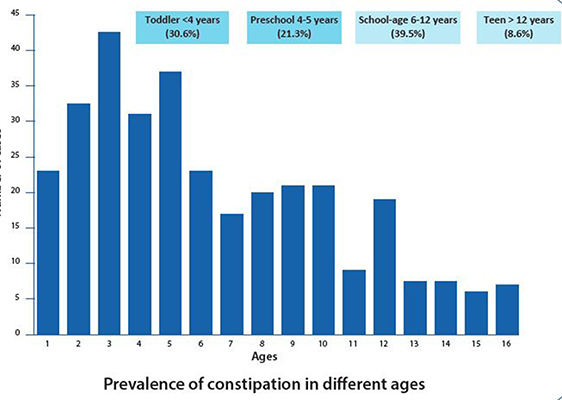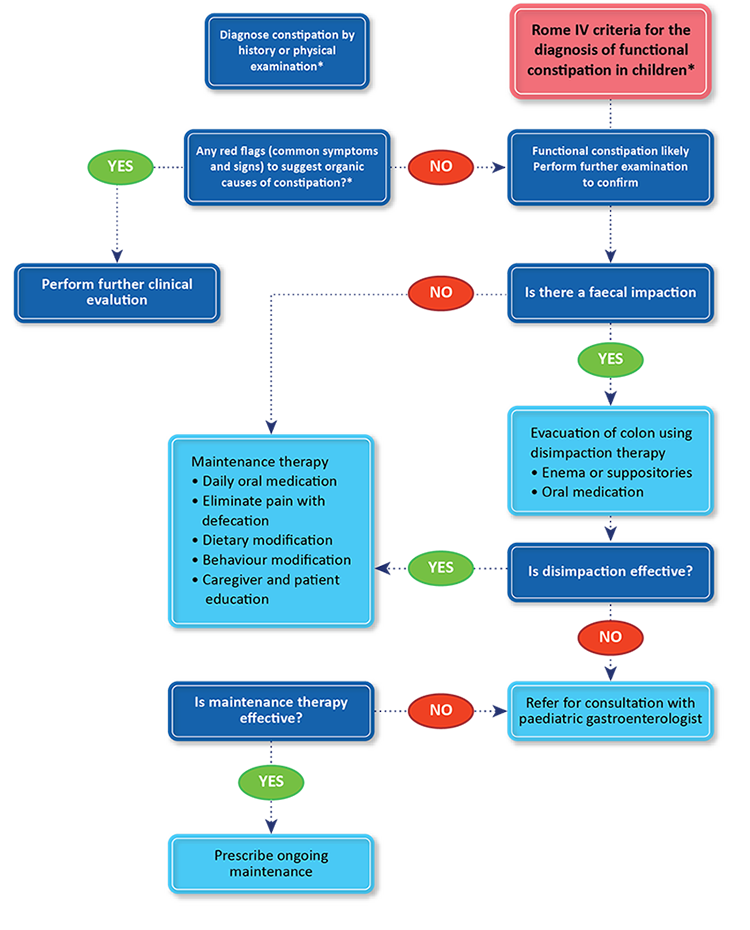Functional constipation is a fairly common problem occurring in childhood. It has a varied prevalence between geographic regions. In North and South America, the prevalence (including infants–adolescents) ranges between 10% and 23% respectively, while in Europe (only including children) numbers between 0.7% and 12% are reported. In Asia (including infants– dolescents), the prevalence is estimated between 0.5% and 29.6%.
The prevalence also varies according to different age groups. The peak incidence of constipation has been reported between 2 and 4 years of age, when the potty training of a child starts. A recent systematic review found that the median prevalence of constipation in children was 12%. The incidence of constipation reported in infants varies between 0.05% and 39.3%, but based on expert consensus the prevalence is estimated at 15%.1


Clinical approach to constipation is governed by the Rome IV guidelines. It
gives a clear picture of the disease and plays an important role in making a
treatment plan for thesame.

Management of severe constipation with fecal impaction includes disimpaction
followed by maintenance therapy with oral laxative, dietary modification and
toilet training. A close and regular follow-up is necessary for successful treatment.
In most cases, the laxative needs to be continued for several months and
sometimes years. Other treatment options include enema and surgical treatment
if any underlying cause exists. Newer approaches to manage constipation include
prebiotic, probiotic or synbiotic therapy to regulate the gut microbial
composition.
The gut microbiome is made up of trillions of microorganisms and is
considered the “body's virtual organ” in lieu of its importance in maintaining
host homeostasis. It comprises of both commensal bacteria such as
bifidobacteria and lactobacilli and non-commensal bacteria such as enterococci
and others that interact with the host in a complex manner.2 Any
kind of imbalance in the gut microbiome is referred to as “dysbiosis” and has
growingly been associated with a lot of diseases in children, including
functional gastrointestinal disorders such as constipation and irritable bowel
syndrome.3,4

Several studies have found that gut microbiome dysbiosis is
associated with constipation in children :
• In a study, the authors found that constipated children were found to have
lower levels of lactobacillus than controls.6
• Meij et al.prospectively enrolled children with intractable constipation and
analyzed their gut microbiomes. He found that children with constipation had
increased abundance of the phyla proteobacteria, increased levels of
bacteroides spp., parabacteroides spp., and decreased levels of alistipes
finegoldii and ruminococcus spp.7
• Zhu et al found out that obese children with constiption consumed less fiber
and had lower levels of prevotella and increased levels of butyrate-producing
taxa (coprococcus, roseburia, and faecalibacterium) than controls.8
Prebiotics, Probiotics and Dietary Interventions for Gut Microbiome
Modulation :
Evidence indicates that dysbiosis of gut microbiota may contribute to
functional constipation and constipation-type irritable bowel syndrome.
Targeting treatments for the dysbiosis of constipation by probiotics,
prebiotics and synbiotics may be a new option, especially for refractory
constipation to conventional therapies.9
• In a study conducted by Junhang et al, prebiotics inulin (INU) and
isomalto-oligosaccharide (IMO) improved constipation and altered the intestinal
microbiota in a rat model of constipation.10
• A study by M. Sadeghzadeh et al revealed significantly increased bowel
frequency and improved stool consistency with the combination of lactulose and
probiotics.11
• Ibarra et al. reported no difference between probiotics and the placebo in
primary analysis, but in a post hoc analysis, they reported that B.animalis
subsp. lactis HN019
(HN019) increased the frequency of spontaneous defecations and
reduced thedegree of straining in patients with functional constipation.12
• A study also shows that probiotics increase stool frequency and have
beneficial effects in childrenupto age 18.13
• An improvement in defecation frequency and abdominal pain was observed using
both supplemented and non-supplemented yogurt, but an additional improvement
with B. longum supplementation was obtained in a study by Paula et al.14
Gut microbiological imbalance is an important factor associated with
functional constipation. A number of mechanisms mediated by microbial
metabolites contribute significantly to its pathogenesis. The therapeutic
effects of probiotics, prebiotics and synbiotics often involve compositional
and functional changes in the gut microbiota and can be an important addition
to conventional therapies in managing constipation.
References: